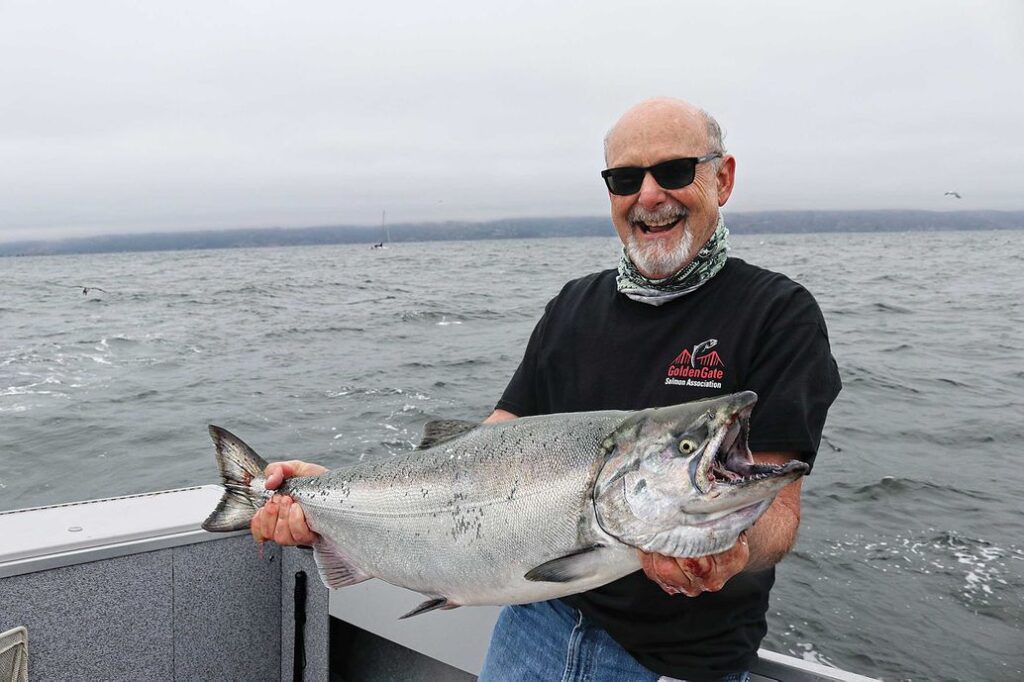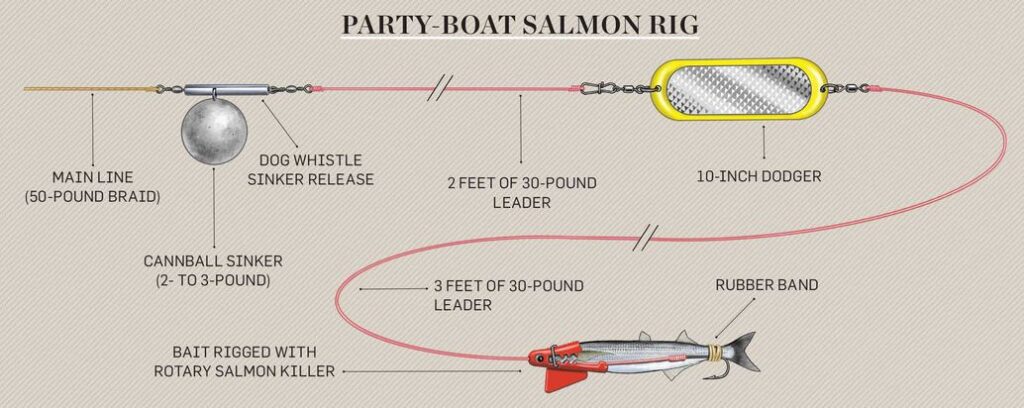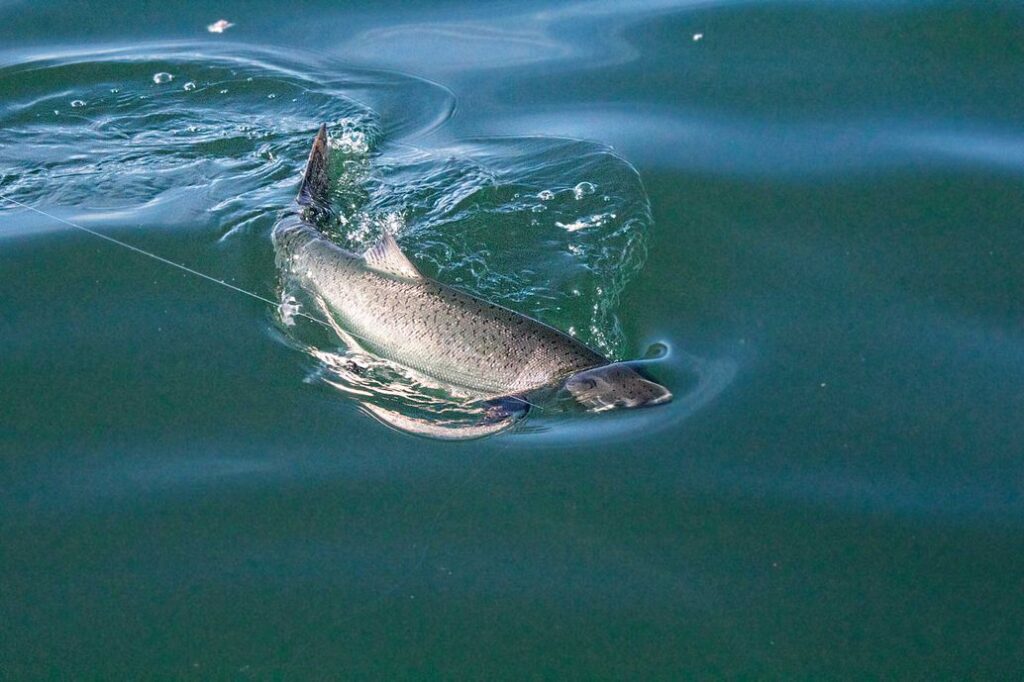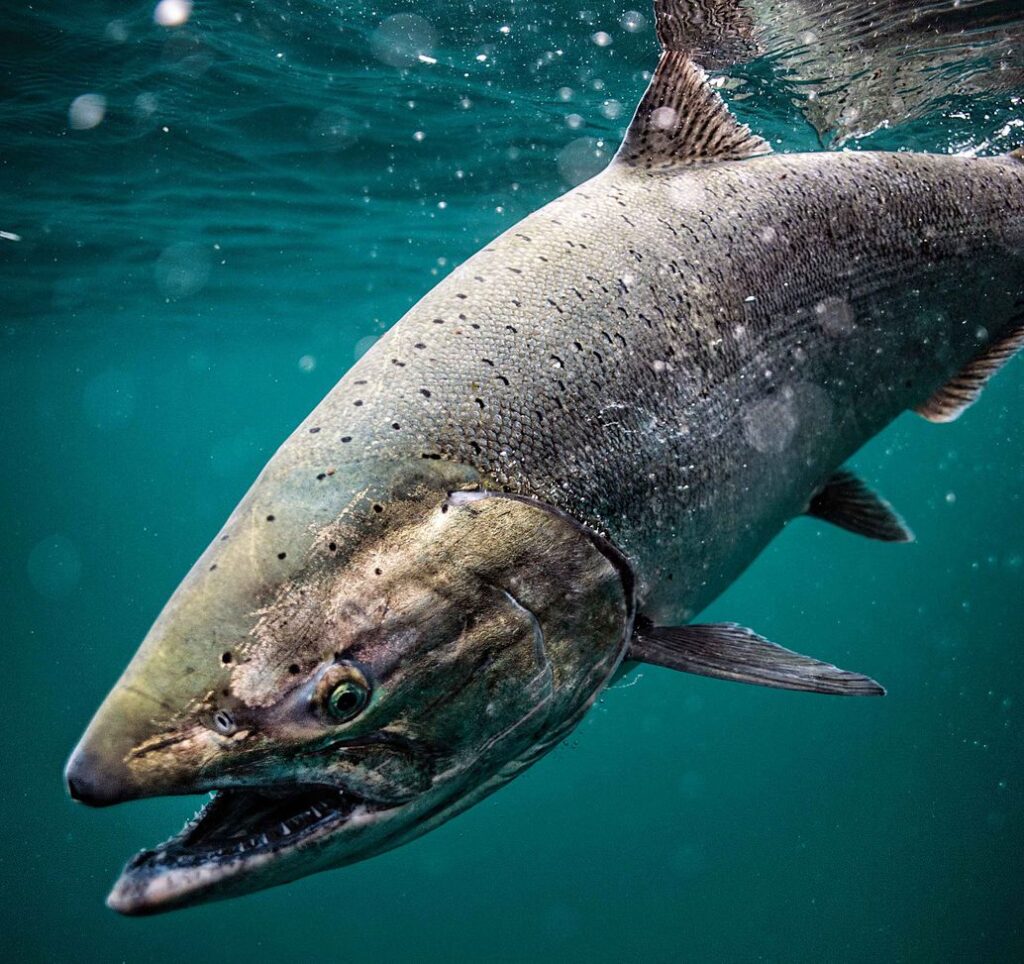Hot action on Northern California salmon.
By Ron Ballanti via https://www.saltwatersportsman.com/story/howto/how-to-catch-california-chinook-salmon/

I gingerly lifted the heavy cannonball sinker and leader over the gunwale, and after pausing briefly to make sure the flasher and bait were spinning properly, I counted off pulls of line aloud as the rig disappeared into the murky waters. I stripped about a foot of line off the reel with each number I called, keeping enough thumb pressure on the spool to maintain control of the 2-pound sinker.
“Put that one down about 30 pulls,” advised my brother Don, figuring that would get the rig to the depth where we were marking large schools of bait on the sounder. Upon reaching 30, I threw the levelwind reel into gear and slid the rod into one of the rail-mounted rod holders. Before I could even get my hands off the rod, it bent in a deep arc as line peeled steadily off the reel.
After a few determined runs, my quarry broke the surface well behind the boat, getting some air on the starboard-side of the boat before cutting back across to port, requiring me to carefully work around the other trolling lines still streaming aft. After a few nerve-racking head shakes alongside the boat, my brother slid the landing net under a 14-pound shimmering chrome king salmon.

Scenes like this have been repeated many times recently off California’s coast as Bay Area anglers enjoyed epic king salmon fishing that began in late spring and lasted right through the summer of 2019. Much of this time, the bite was centered only a short run from San Francisco, in easy range of throngs of private skiffs and party boats. Bragging rights weren’t about if you caught limits for all on board, but how quickly you got it done.
The reason can be summed up in one word: water. “Heavy rains like those we had in the spring of 2017 have a huge impact on the survival of baby salmon coming downriver,” says John McManus of the Golden State Salmon Association (known previously as the Golden Gate Salmon Association). This applies to both the state’s natural king salmon, as well as the roughly 32 million hatchery fish released each year, 50 percent of which are simply released into the river systems to fend for themselves.
McManus predicts that based on recent rainfall levels, the 2020 salmon season should be a good one, but probably won’t match last year’s bonanza. “The fish are one-year-olds coming out of the rivers, and we’re primarily fishing for three-year-olds in the 15- to 20-pound range,” he says. As most Californians know, the winter of 2018-2019 was a particularly wet one, which should bode well for salmon action next spring and summer. “Book your trips now for the 2021 season; it should be great based on water flows,” McManus says.

Salmon Search
The first step for private boaters is figuring out where the fish are likely to be on any given day. King salmon stage off the coast to feed and fatten up before moving into San Francisco Bay, and eventually into the American or Sacramento river systems. They are always on the move in search of forage and good water conditions. In this case, however, good means the ugliest, brownest water you can find. That dirty water indicates a rich soup of plankton and krill, just the food-chain starter that schools of anchovy seek. Certain well-known areas, such as Duxbury Reef and the waters off Stinson Beach, are consistent salmon producers. Still, it’s better to focus on finding the right conditions than to get hung up on fishing particular spots.
Successful salmon anglers are constantly watching the sounder for schools of bait, while also keeping an eye out for above-water signs. Some are hard to miss, such as whales feeding and flocks of sea gulls crashing the surface. Others, such as groups of murres sitting on the surface, are more subtle. Mother murres dive to grab baitfish while leaving their young floating on the surface. The baby birds cry out repeatedly to help their parents relocate them once they resurface, providing an audio-visual indication that fish are likely around.

Chinook Tactics
California king salmon are mostly targeted by trolling frozen anchovy or herring baits, using a downrigger or sinker release rig to get the bait down into the strike zone. A sinker release rig utilizes a 2- to 3-pound lead ball that is attached to the line using a device that allows the sinker to drop off the line when a fish is hooked. This rig enables boats without downriggers to get in the game, and it’s designed to let anglers fight the salmon without any weight on the line. The obvious downside is that you send a big lead sinker to the bottom every time you hook a fish. San Francisco area party boats specializing in salmon trolling often go out with 20 or more people. That eliminates downriggers as an option. Instead, anglers deploy sinker rigs all around the boat, including the bow, and the crew sets the lines at different depths to avoid tangles. When a fish is hooked along the side of the boat or in the bow (which happens more than you would think), a crewmember deftly walks the fish toward the stern, weaving around other anglers’ lines until the fish is in the clear to bring aboard.
Fit for a King
Gear for this type of salmon fishing is simple but specialized. A small to medium conventional, levelwind reel with 55-pound braid and a short top shot of 30-pound mono or fluorocarbon will do, matched with a soft, medium-action 7- or 8-foot rod that can handle dragging 2 pounds of lead around at a couple of knots, yet is forgiving enough to avoid tearing barbless hooks from the soft mouths of king salmon. Downrigger fishermen favor specialized rods with soft tips that prevent the line from pulling out of the release clips when bouncing around on the swells. A flasher or dodger is rigged between the main line and the leader, which is often 30-pound fluorocarbon for added abrasion resistance.

Your bait must spin consistently as it tracks through the water, and avid salmon anglers use a variety of rigs to achieve this. The foolproof options available at most tackle shops include the Rotary Salmon Killer and Franko Bait Rotator, which allow you to simply insert and secure a whole dead bait into a plastic head. These are often rigged with single or double barbless hooks. (California regulations require barbless hooks when salmon fishing.)

King salmon aren’t as powerful as tuna or yellowtails, but they seem to save most of their strength for when they’re right next to the boat. Keeping steady pressure, not allowing any slack, is essential. Chinook often charge the boat during the fight, and will almost assuredly go berserk just out of net range. Keep your wits about you, communicate with your net man, and you might just come home feeling like a king.
California Salmon Regs
Salmon regulations, including opening and closing dates for specific regions of the California coast, gear restrictions and other rules, can often change, even during the season. Make sure you understand the latest salmon regulations by contacting the California Department of Fish and Wildlife office or visiting wildlife.ca.gov.

Fighting for Salmon
The Golden State Salmon Association is dedicated to fighting for California salmon. Its efforts include fighting for adequate water flow in California’s dammed-up rivers, restoring habitat, and providing a helping hand when Mother Nature doesn’t cooperate with enough rain. Five hatcheries on the Merced, American, Feather and Mokelumne rivers and Battle Creek, a tributary of the Sacramento River, are key to northern California’s salmon fishery. Half of the 32 million fish raised annually are released into the rivers to ensure enough returns for egg taking. The other half are trucked and released into the ocean to increase their chances of survival—efforts enhanced by holding the fish in pens to acclimate, as well as releasing them during an outgoing tide, and moving release points around to minimize predation. Learn more at goldenstatesalmon.org.
